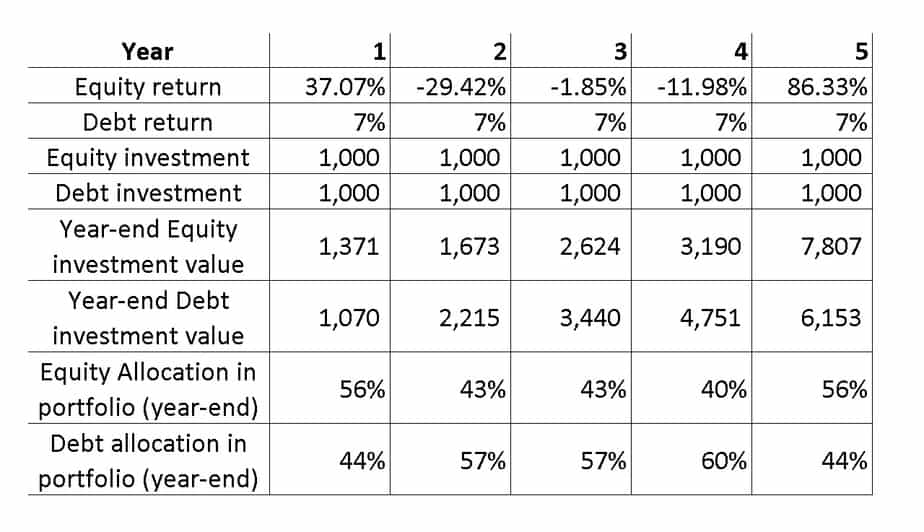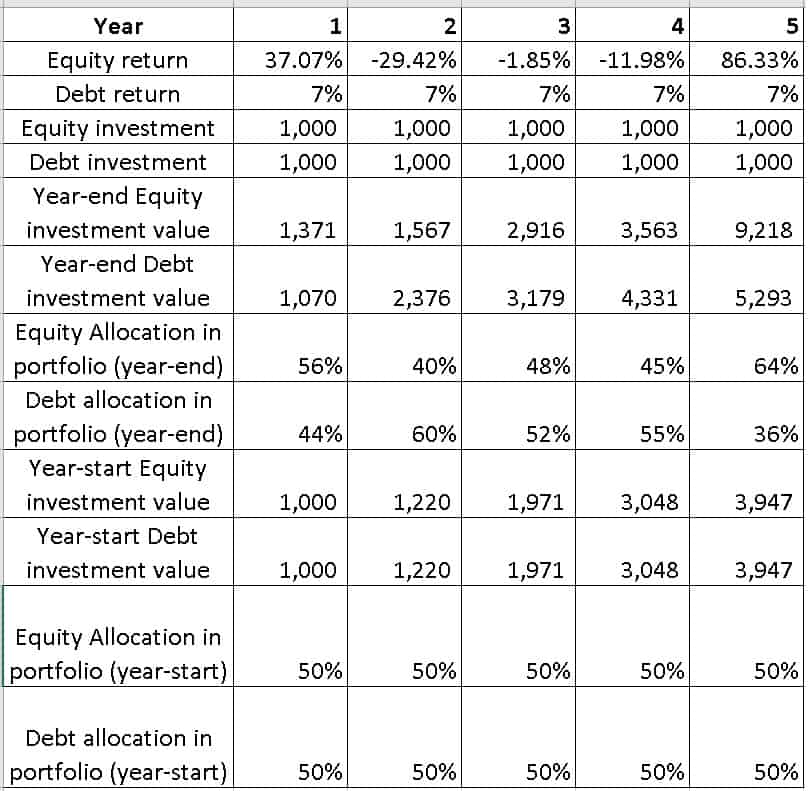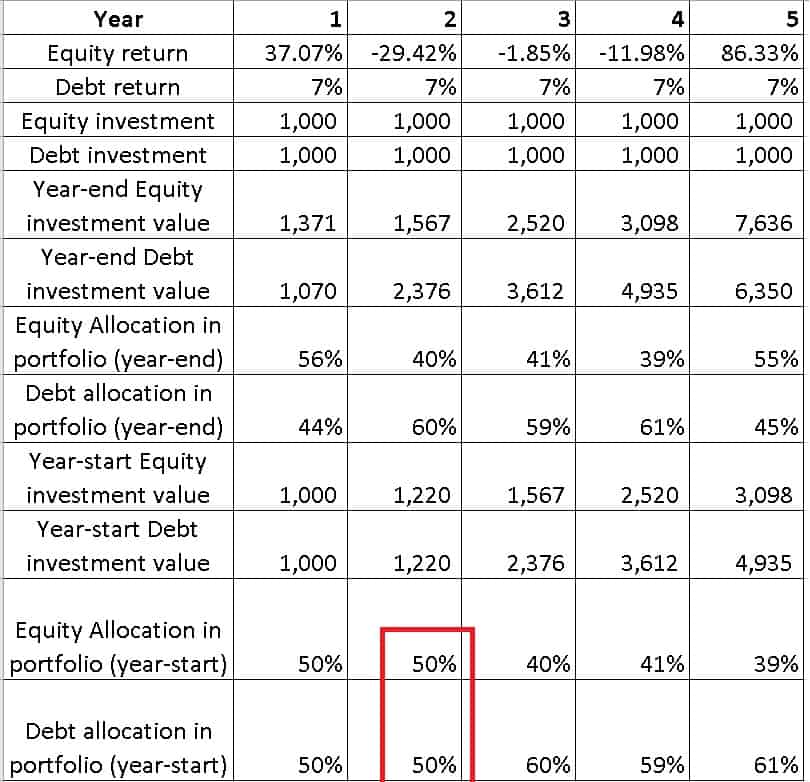Last Updated on February 12, 2022 at 6:15 pm
Profit-booking is a colloquial trade name for selling stocks or mutual funds. Many investors are confused by what it actually refers to and how it is different from terms like redemption and rebalancing. This is a simple explanation for newbies.
Let us understand profit booking with an example. Suppose you purchased 100 stocks of a company for Rs. 10. The initial investment value is Rs. 1000. After many months, the stock price is now Rs. 24.56. So the investment value is Rs. 2456. Our minds see this Rs. 1000 + Rs. 1456. Suppose you wish to “book” this profit of Rs. 1456.
This is not a bank account where you can withdraw this amount. You will have to sell some shares. Now 1456/24.56 = 59.28. You cannot sell 59.28 shares. It must either be 59 stocks or 60 stocks. Fractional units can be sold in mutual funds, but the logic is the same.
If you sell, 59 shares at 24.56, you get Rs. 1449. Is this really “profit” booking? This Rs. 1449 has two components: (59 x 10) + (59 x 14.56). Here 59 x 10 = 590 is the money invested or the principal. The stock price appreciation is Rs. 14.56 and the gain is (59 x 14.56). Thus every sale or every redemption of stocks or mutual funds will always have two components: the principal +/- capital gain or loss.
Join 32,000+ readers and get free money management solutions delivered to your inbox! Subscribe to get posts via email! (Link takes you to our email sign-up form)
🔥Want to create a complete financial plan? Learn goal-based investing? Exclusive access to our DIY tools? Increase your income with your skills? Use this link to enjoy massive discounts on our robo-advisory tool & courses! 🔥
This idea of Rs. 1000 appreciating to Rs. 2456 and removing Rs. 1456 as “profit” is incorrect mental accounting (just like we hope 2021 will be better than 2020 because a microorganism can differentiate between Dec 31st and Jan 1st as we do).
We had discussed that good returns from years and years of stock market investing is determined by just two or three big up moves: Sensex return is 16% plus over last 41 years but half of that came from just three good years! The Sensex is still haunted by the 270% annual gain because of the Harshad Mehta scam. Remove this and returns are poor.
Sensex or Nifty has seen some 80% annual returns during the 2000s including the recovery from the 2008 financial crisis. It is a no brainer that we need we need to be invested in the market during these big return years. Else our overall return is going to be poor.
Let us now consider another example of such “profit booking” but let us do so with an asset allocation in mind. That is, we would like to invest 50% of our money in equity and 50% in fixed income. After each year, we find out how much this allocation has changed and “correct” it by booking profit from equity and buying more of fixed income or by booking profit from fixed income and buying more of equity as per the situation.
Let us consider the growth of a portfolio over five years. We shall assume a 7% return per year from fixed income to keep things simple. We shall ignore taxes and exit loads to keep things simple. For equity, we shall assume the following sequence of return:
- After year 1: 37.07%
- After year 2: -29.42%
- After year 3: -1.85%
- After year 4: -11.98%
- After year 5: 86.33%
These are real returns from the Sensex. A person who started investing in April 1999 would have gone through this journey. These are randomly chosen and the results obtained are also therefore random. In real-time, no one can tell which strategy will work better. Please do not read too much into the numbers. The idea is to show how “profit booking” works.
The figure below shows how Rs. 1000 invested each year(!) changes in value for given equity and debt (fixed income) annual returns. We start with 50% equity and 50% fixed income but notice how the debt asset allocation swings from 44% to 60% because of return fluctuations in equity.

Now we would like to ensure the year-start asset allocation is always 50% equity and 50% debt. At the start of year one, the invested value was Rs. 1000 in equity and Rs. 1000 in debt. At the end of year one, equity became Rs. 1,371 and debt Rs. 1070.
Suppose we “book profit” (with the above-explained meaning) of Rs. 151 from equity and invest it in debt, at the start of year two (= end of year one), the equity allocation is Rs. 1220, the debt allocation is also Rs. 1220. So we have now reset the allocation from 56% equity to 50% equity by some “profit booking”.
Now many people do not like this term. It sounds crass, not to mention it is mental accounting and wrong. So we shall henceforth refer to this “rest” as portfolio rebalancing. The table below shows the evolution of the portfolio after four years of annual rebalancing (end of year 2,3,4 and 5).

For this particular example set, the portfolio values after five years with no rebalancing is Rs. 7807 (equity) and Rs. 6153 (debt). With annual rebalancing this becomes Rs. 9218 (equity) and Rs. 5293 (debt). The reason you ended up with more money in equity (and overall) is simple. We had about 24% more money in equity before that 86% return in year 5.
I do not want to use this singular example to sing the praise of regular rebalancing. Sometimes regular rebalancing will result in a higher corpus and sometimes not. We would know only in real-time. At the very least, rebalancing helps you sleep better. You booked some “profit” after a 37% return from equity and you invested more when you saw a -29% return.
An alternative (certainly not superior) is one-way rebalancing. That is, you book “profits” only when equity returns are positive or super positive or if the year-end equity allocation is 5% more than what you wish it to be. This will gradually build more corpus in debt.
For example, in the picture below, we rebalance only if equity returns are positive, at the start of year two for example as shown in red. We do not consider a rebalance at the end of year 5 because there is no sixth year in our example.

This results in 20% more corpus in debt. We do not know beforehand “which strategy is better?” Looking for an answer to this is a waste of time. However, for a particular goal, we can combine two-way and one-way rebalancing.
Initially, we rebalance both ways. That is book profit from equity and shift to debt or vice versa as per the year-end asset allocation. After a few years, you can focus on gradually building debt corpus by one-way rebalancing. If you have additional funds from elsewhere you can invest more on equity dips as well but it better not to factor future cash flows now. If you have any questions, you can post them in our YouTube community
Related question: Can I book excess returns from equity funds as profit from time to time?
Finally, keep in mind the above illustrations make no attempt to reduce equity allocation to lower risk. This is an extremely important step to ensure we achieve our goal corpus no matter what the market conditions or – bull market, bear market or range-bound market. This has to be factored in from day one otherwise the invested amount will be lower. The robo advisory template automates this process. Different strategies to vary equity allocation before and after retirement and what works is covered in lectures on goal-based portfolio management.

Use our Robo-advisory Tool to create a complete financial plan! ⇐More than 3,000 investors and advisors use this! Use the discount code: robo25 for a 20% discount. Plan your retirement (early, normal, before, and after), as well as non-recurring financial goals (such as child education) and recurring financial goals (like holidays and appliance purchases). The tool would help anyone aged 18 to 80 plan for their retirement, as well as six other non-recurring financial goals and four recurring financial goals, with a detailed cash flow summary.
🔥You can also avail massive discounts on our courses and the freefincal investor circle! 🔥& join our community of 8000+ users!
Track your mutual funds and stock investments with this Google Sheet!
We also publish monthly equity mutual funds, debt and hybrid mutual funds, index funds, and ETF screeners, as well as momentum and low-volatility stock screeners.
You can follow our articles on Google News

We have over 1,000 videos on YouTube!

Join our WhatsApp Channel



- Do you have a comment about the above article? Reach out to us on Twitter: @freefincal or @pattufreefincal
- Have a question? Subscribe to our newsletter using the form below.
- Hit 'reply' to any email from us! We do not offer personalised investment advice. We can write a detailed article without mentioning your name if you have a generic question.
Join 32,000+ readers and get free money management solutions delivered to your inbox! Subscribe to get posts via email! (Link takes you to our email sign-up form)
About The Author
 Dr M. Pattabiraman (PhD) is the founder, managing editor and primary author of freefincal. He is an associate professor at the Indian Institute of Technology, Madras. He has over 13 years of experience publishing news analysis, research and financial product development. Connect with him via Twitter(X), LinkedIn, or YouTube. Pattabiraman has co-authored three print books: (1) You can be rich too with goal-based investing (CNBC TV18) for DIY investors. (2) Gamechanger for young earners. (3) Chinchu Gets a Superpower! for kids. He has also written seven other free e-books on various money management topics. He is a patron and co-founder of “Fee-only India,” an organisation promoting unbiased, commission-free, AUM-independent investment advice.
Dr M. Pattabiraman (PhD) is the founder, managing editor and primary author of freefincal. He is an associate professor at the Indian Institute of Technology, Madras. He has over 13 years of experience publishing news analysis, research and financial product development. Connect with him via Twitter(X), LinkedIn, or YouTube. Pattabiraman has co-authored three print books: (1) You can be rich too with goal-based investing (CNBC TV18) for DIY investors. (2) Gamechanger for young earners. (3) Chinchu Gets a Superpower! for kids. He has also written seven other free e-books on various money management topics. He is a patron and co-founder of “Fee-only India,” an organisation promoting unbiased, commission-free, AUM-independent investment advice.Our flagship course! Learn to manage your portfolio like a pro to achieve your goals regardless of market conditions! ⇐ More than 3,500 investors and advisors are part of our exclusive community! Get clarity on how to plan for your goals and achieve the necessary corpus no matter the market condition!! Watch the first lecture for free! One-time payment! No recurring fees! Life-long access to videos! Reduce fear, uncertainty and doubt while investing! Learn how to plan for your goals before and after retirement with confidence.
Increase your income by getting people to pay for your skills! ⇐ More than 800 salaried employees, entrepreneurs and financial advisors are part of our exclusive community! Learn how to get people to pay for your skills! Whether you are a professional or small business owner seeking more clients through online visibility, or a salaried individual looking for a side income or passive income, we will show you how to achieve this by showcasing your skills and building a community that trusts and pays you. (watch 1st lecture for free). One-time payment! No recurring fees! Life-long access to videos!
Our book for kids: “Chinchu Gets a Superpower!” is now available!


Must-read book even for adults! This is something that every parent should teach their kids right from their young age. The importance of money management and decision making based on their wants and needs. Very nicely written in simple terms. - Arun.Buy the book: Chinchu gets a superpower for your child!
How to profit from content writing: Our new ebook is for those interested in getting a side income via content writing. It is available at a 50% discount for Rs. 500 only!
Do you want to check if the market is overvalued or undervalued? Use our market valuation tool (it will work with any index!), or get the Tactical Buy/Sell timing tool!
We publish monthly mutual fund screeners and momentum, low-volatility stock screeners.
About freefincal & its content policy. Freefincal is a News Media organisation dedicated to providing original analysis, reports, reviews and insights on mutual funds, stocks, investing, retirement and personal finance developments. We do so without conflict of interest and bias. Follow us on Google News. Freefincal serves more than three million readers a year (5 million page views) with articles based only on factual information and detailed analysis by its authors. All statements made will be verified with credible and knowledgeable sources before publication. Freefincal does not publish paid articles, promotions, PR, satire or opinions without data. All opinions will be inferences backed by verifiable, reproducible evidence/data. Contact Information: To get in touch, please use our contact form. (Sponsored posts or paid collaborations will not be entertained.)
Connect with us on social media
- Twitter @freefincal
- Subscribe to our YouTube Videos
- Posts feed via Feedburner.
Our publications
You Can Be Rich Too with Goal-Based Investing
 Published by CNBC TV18, this book is designed to help you ask the right questions and find the correct answers. Additionally, it comes with nine online calculators, allowing you to create custom solutions tailored to your lifestyle. Get it now.
Published by CNBC TV18, this book is designed to help you ask the right questions and find the correct answers. Additionally, it comes with nine online calculators, allowing you to create custom solutions tailored to your lifestyle. Get it now.Gamechanger: Forget Startups, Join Corporate & Still Live the Rich Life You Want
 This book is designed for young earners to get their basics right from the start! It will also help you travel to exotic places at a low cost! Get it or gift it to a young earner.
This book is designed for young earners to get their basics right from the start! It will also help you travel to exotic places at a low cost! Get it or gift it to a young earner.Your Ultimate Guide to Travel
 This is an in-depth exploration of vacation planning, including finding affordable flights, budget accommodations, and practical travel tips. It also examines the benefits of travelling slowly, both financially and psychologically, with links to relevant web pages and guidance at every step. Get the PDF for Rs 300 (instant download)
This is an in-depth exploration of vacation planning, including finding affordable flights, budget accommodations, and practical travel tips. It also examines the benefits of travelling slowly, both financially and psychologically, with links to relevant web pages and guidance at every step. Get the PDF for Rs 300 (instant download)